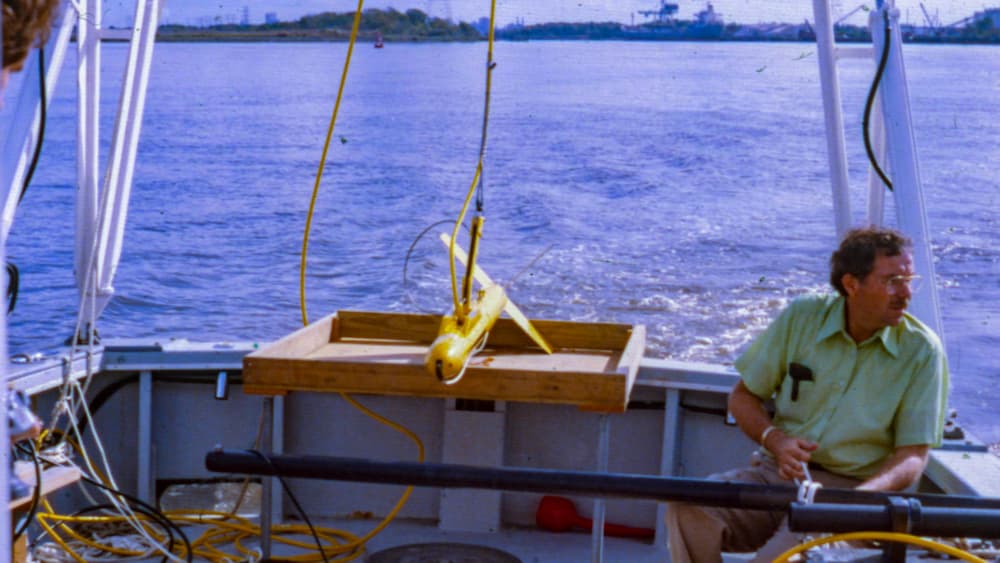Jim Henry and Jesse Hunt

Dr. Vernon J. "Jim" Henry (1932 - 2010)
Dr. Vernon J. "Jim" Henry was an early investigator of the geologic foundation of Gray's Reef. The importance of his early work developed both the framework of following geologic studies and enhanced the appreciation and understanding of Gray's Reef.
In 1974, Jim guided the first geological surveys of Gray's Reef with Jesse Hunt, a graduate student at the University of Georgia (UGA) Sapelo Island Marine Institute. Jim and Jesse were the very first scientists to map the geology and extent of Gray's Reef. These surveys paved the way for the national marine sanctuary designation in 1981. Dr. Henry furthered his support of the sanctuary by volunteering as the inaugural chair of the Sanctuary Advisory Council, serving for two terms (1999 – 2002). Jim continued advocating for the protection of natural resources by establishing the Center for a Sustainable Coast and the Georgia Chapter of Wilderness Watch.
In 1996, the National Oceanic & Atmospheric Administration recognized Dr. Jim Henry with an "Environmental Hero" award for his work on Gray's Reef National Marine Sanctuary.
In addition to Henry's important work on Gray's Reef, his long and distinguished career included teaching, research, and administrative roles within the University System of Georgia: Director of the University of Georgia (UGA) Marine Institute on Sapelo Island (1961-1971); coordinator of the UGA marine geology program on Skidaway Island (1971-1982); Chairman and Professor Emeritus of the Department of Geology at Georgia State University (1982-1992); and part-time Professor of Geology and Director of the Georgia Southern University Applied Coastal Research Lab (ACRL) on Skidaway Island (1992-2003).
Dr. Jim Henry was one of the most respected geologists in Georgia and as such was frequently called upon to guide environmental policy in the State. His leadership of the Georgia Coastal Advisory Council was critical in the 1992 formation of the Georgia Coastal Zone Management Program. After his retirement from the University System of Georgia in 2003 and up until his death, Dr. Henry kept an office at the ACRL, staying active in barrier island research and the environmental community.
In 2020, Dr. Henry was an honoree of the Office of National Marine Sanctuaries Memorial Garden in Key West, FL. These garden honorees are nominated and selected by peers in the National Marine Sanctuary System, and are recognized for their outstanding and honorable service. They represent the many faces, facets, and professions needed to operate the various functions at the national marine sanctuaries.
Jesse Hunt

Jesse Hunt was a graduate student studying coastal geology at the University of Georgia during the early-1970s. His master's thesis studied the bedrock structures of the ‘Sapelo live bottom'—named at the time for its proximity to the island. Jesse worked with Dr. Jim Henry using sound surveys and scuba diving to explore the Sapelo live bottom and gain a better understanding of its origins and makeup.
In 1972, Hunt suggested to Dr. Henry that the colloquial ‘Sapelo live bottom' area needed a formal name. Hunt submitted paperwork to the U.S. Board of Geographic Names in Washington, DC requesting to make "Gray's Reef" the official name of the area named after Milton "Sam" Gray. Support for the name change was stalled until the Georgia Department of Natural Resources (Georgia DNR) backed the name change in 1974. Georgia DNR submitted a nomination to the Secretary of Commerce in June 1978 recommending the designation of Gray's Reef as a national marine sanctuary. Georgia environmental activist Jane Yarn was instrumental in getting the Gray's Reef designation documents to president Jimmy Carter's desk as well as in getting other important Georgia environmental areas protected.

